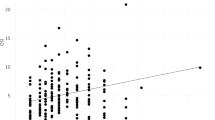Abstract
The direct compensation method allows for an accurate determination of intraocular light scattering between 3.5 and 25 degrees of scattering angle and is suitable for untrained subjects. The method was used to study light scattering in four forms of hereditary corneal dystrophies. Light scattering is the basis of glare complaints and was compared with visual acuity loss. The findings corresponded to the complaint patterns: in central crystalline dystrophy light scattering can be much increased with relatively well preserved visual acuity. In posterior polymorphous dystrophy the reverse is true. In macular dystrophy (Groenouw II) and lattice dystrophy the situation is more or less intermediate between these two extremes.
Similar content being viewed by others

References
Delleman JW, Winkelman JE. Degeneratio corneae cristallinea hereditaria: A clinical, genetical and histological study. Ophthalmologica 1968; 155: 406–26.
van den Berg, TJTP. Importance of pathological intraocular scatter for visual disability. Doc Ophthalmol 1986; 61: 327–33.
Vos JJ. On mechanisms of glare Diss. Utrecht, 1963.
Vos JJ. Disability glare: A state of the art report CIE-Journal 1984; 3(2): 39–53.
Holladay LL. The fundamentals of glare and visibility. J Opt Soc Am 1926; 12: 271–319.
Stiles WS. The effect of glare on the brightness difference threshold. Proc Roy Soc 1929; 104B: 322–55.
van den Berg TJTP, IJspeert JK. Intraocular straylight, studied using the direct compensation technique. Commission International de l'Eclairage, 22nd session (Melbourne) 1991; Vol. 1, Part 1, Div. 1: 83–84.
van den Berg TJTP, IJspeert JK. The straylightmeter. In Technical Digest on Noninvasive Assessment of the Visual System Washington DC: OSA, 1991; 1: 256–259.
van den Berg TJTP. Red glasses and visual function in retinitis pigmentosa. Doc Ophthalmol 1990; 73: 255.
de Waard PWT, IJspeert JK, van den Berg TJTP, de Jong PTVM. Intraocular light scattering in age-related cataracts. Invest Ophthalmol Vis Sc: 1992; 33: 618–25.
Cobb PW. The influence of illumination of the eye on visual acuity. Am J Physiol 1911; 29: 76–99.
van den Berg TJTP, Spekreijse H. Measurement of the straylight function of the eye in cataract and other optical media disturbances by means of a direct compensation method. Invest Ophthalmol Vis Sci 1987; 28 (suppl): 397.
Miller CA, Krachmer JH. Dystrophies. In Kaufman HE, McDonald MB, Barron BA, Waltman SR eds, The Cornea New York: Churchill Livingstone, 1988: 383–440.
IJspeert JK, de Waard PWT, van den Berg TJTP, de Jong PTVM. The intraocular straylight function in 129 healthy volunteers: Dependence on angle, age and pigmentation. Vision Res 1990; 30: 699–707.
van den Berg TJTP. On the relation between glare and straylight. Doc Ophthalmol 1991; 78: 177–81.
Author information
Authors and Affiliations
Rights and permissions
About this article
Cite this article
Van Den Berg, T.J.T.P., Hwan, B.S. & Delleman, J.W. The intraocular straylight function in some hereditary corneal dystrophies. Doc Ophthalmol 85, 13–19 (1993). https://doi.org/10.1007/BF01268096
Accepted:
Issue Date:
DOI: https://doi.org/10.1007/BF01268096



